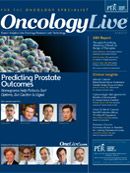Oral HPV Infection Affects 7% of the US Population
Approximately 7% of Americans are infected with oral human papillomavirus (HPV), and men are 3 times as likely to be infected as women.
Maura Gillison, MD, PhD
Professor, College of Medicine Jeg Coughlin Chair of Cancer Research The Ohio State University Comprehensive Cancer Center Columbus, OH
Approximately 7% of Americans are infected with oral human papillomavirus (HPV), and men are 3 times as likely to be infected as women, according to an analysis that helps define a leading factor in the rise of oropharyngeal cancer.
The findings of the HPV prevalence study were presented at the Multidisciplinary Head and Neck Symposium in Phoenix, Arizona, in January and concurrently published in the Journal of the American Medical Association.1
The cross-sectional study was based on samples taken from 5579 men and women between the ages of 14 to 69 years that were obtained at mobile examination centers as part of the National Health And Nutrition Examination Survey (NHANES) 2009-2010. The samples were obtained through an oral rinse and gargle, with subsequent DNA samples used to determine HPV type. Demographic data were obtained using standardized interviews.
HPV prevalence in the overall study population was 6.9% (95% confidence interval [CI], 5.7%-8.3%). HPV type 16, which accounts for 90% of HPVpositive oropharyngeal squamous cell carcinomas, was the most common form, affecting 1.0% of the study population (95% CI, 0.7%-1.3%).
Prevalence of HPV was significantly higher in men versus women (10.1% [95% CI, 8.3%- 12.3%] for men compared with 3.6% [95% CI, 2.6%- 5.0%] for women; P < .001]). Sexual contact was identified as a major factor in the rate of infection, with 7.5% of those who had experienced any form of sexual contact (95% CI, 6.1%-9.1%) infected, compared with 0.9% (95% CI, 0.4%-1.8%; P < .001) of those without a history of any form of sexual contact.
“This study of oral HPV infection is the critical first step toward developing potential oropharyngeal cancer prevention strategies,” Maura Gillison, MD, PhD, lead author of the study, said during a press conference at the symposium. “This is clearly important because HPV-positive oropharyngeal cancer is poised to overtake cervical cancer as the leading type of HPV-caused cancers in the US. We currently do not have another means to prevent or detect these cancers early.”
Prevalence of HPV Infection
in the US Population, 2009-20101
Characteristic
Number in Study
(With Infection)
HPV Prevalence
(%)
Sex
Male
2748 (295)
10.1
Female
2753 (113)
3.6
Age
14-17
656 (16)
1.7
18-24
792 (45)
5.6
25-29
463 (32)
7.1
30-34
436 (39)
7.3
35-39
461 (31)
5.4
40-44
495 (30)
6.3
45-49
482 (37)
7.3
50-54
474 (50)
8.3
55-59
381 (47)
11.2
60-64
498 (55)
11.4
65-69
363 (26)
4.2
Further analysis identified risk factors for infection: HPV prevalence in men and women who had more than 20 sexual partners in their lifetime was 20.5% (95% CI, 17.4%-23.9%); among those who smoked more than 20 cigarettes a day, HPV prevalence was 20.7% (95% CI, 12.6%-32.0%).
Although cigarette and alcohol use have classically been associated with the disease, Gillison said that this study suggests that oral HPV is predominantly sexually transmitted. As to why men had a higher overall rate of HPV prevalence than women, the study authors suggested factors such as sexual behavior (ie, does a higher probability of transmitting HPV through oral sex on women compared to men exist?) and hormonal differences affecting the duration of infection.
Overall, the incidence of HPV-positive oropharyngeal cancers increased by 225% between 1988 and 2004, according to National Cancer Institute research. There were an estimated 6700 cases of HPV-positive oropharyngeal cancers in 2010, up from 4000 to 4500 in 2004.
Gillison said that the study was not necessarily designed to be used to advocate for vaccinating boys and girls before they become sexually active. However, Gillison said that large, prospective studies on the effectiveness of HPV vaccinations should be the next step in determining whether the vaccinations should be made mandatory at a national or global level.
Human papillomavirus (HPV)
“It’s difficult to make public policy recommendations based on a hope or a speculation,” Gillison said.
1. Gillison ML, Broutian T, Pickard RK, et al. Prevalence of oral HPV infection in the United States, 2009-2010. JAMA. 2012; 307(7):published online ahead of print January 26, 2012. doi:10.1001/jama.2012.101




